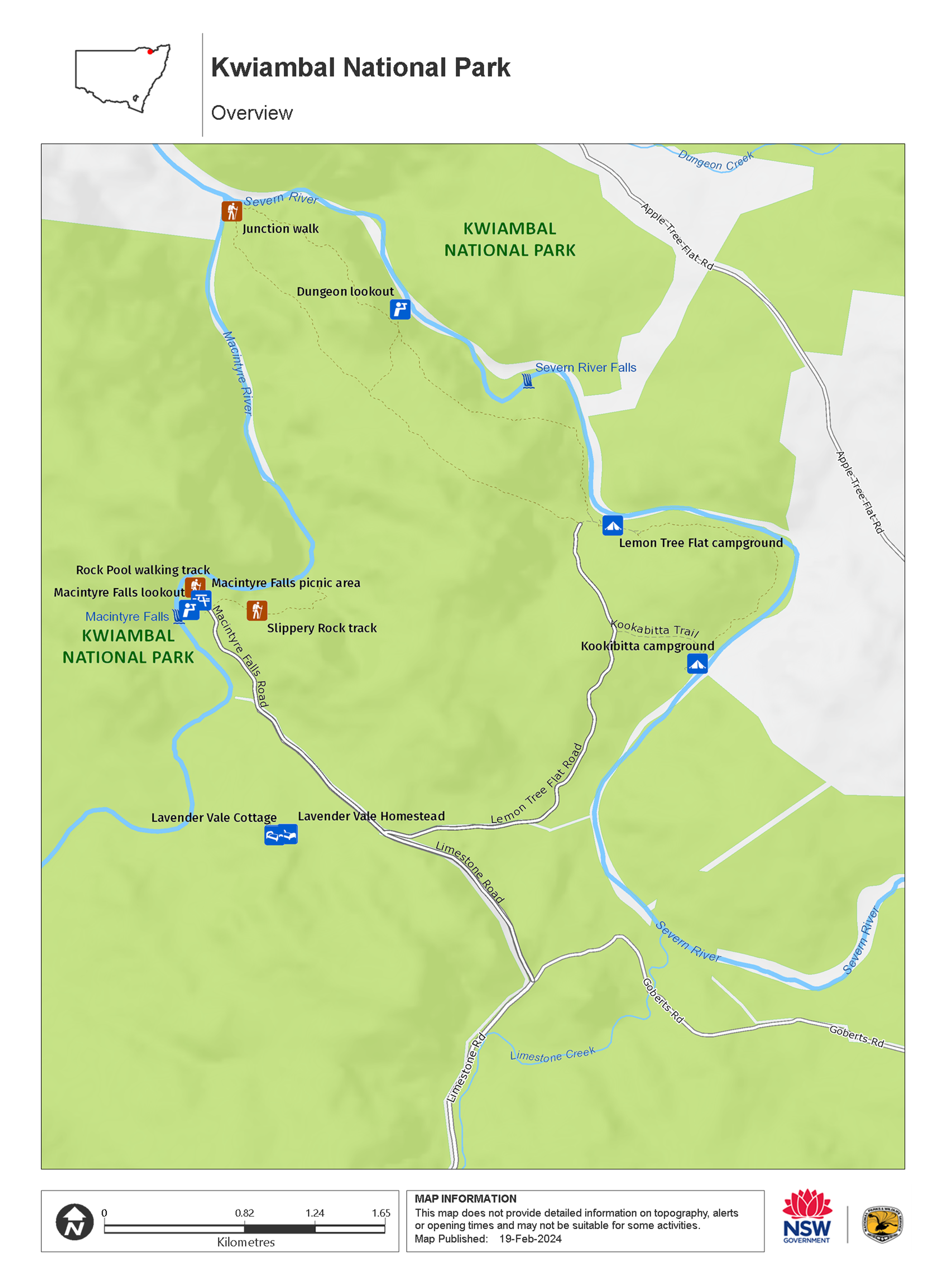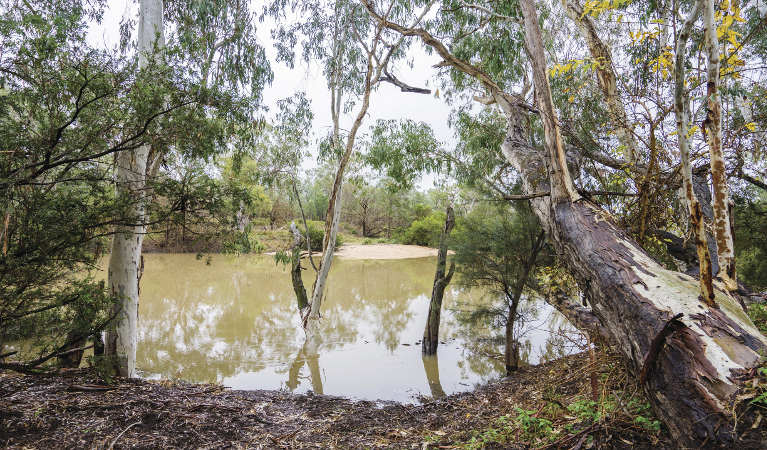Kwiambal National Park
Overview
Kwiambal National Park is a secluded reserve past Inverell offering swimming, scenic picnic opportunities, cheap accommodation, mountain biking, birdwatching and fishing.
Read more about Kwiambal National Park
Pronounced Kigh-am-bal, Kwiambal National Park is a quiet achiever. Tucked away near the NSW-Queensland border, its isolation is also its attraction: come for the nature, stay for the privacy. There’s a good chance you’ll have a great deal of space to yourself, with day trippers travelling through the outback and grey nomads the most frequent visitors in the area.
Though the park has a history of tobacco farming, white cypress-pines and ironbarks are in ready supply, accompanying dramatic granite gorges and twisting waterways that thunder after heavy storms. The open plains are often covered with kangaroos – stick around for dusk and dawn and you might even see the resident emus.
Kwiambal offers multiple opportunities for swimming and fishing, with plentiful river species for the taking. The rivers themselves are a prime attraction too, offering plunge pools, beaches, and scenic waterfalls best seen from one of the several lookouts scattered around the park. Walking trails thread through cool forest and are scaled for many levels of fitness. Pull on the hiking boots and then reward your efforts with a barbecue at one of the several picnic spots, perfect for a weekend getaway.
Bring your tent or caravan, or enjoy some budget accommodation. Kwiambal offers a surprising variety of options – something for everyone, space enough for all.
Local alerts
For the latest updates on fires, closures and other alerts in this area, see https://www.nationalparks.nsw.gov.au/visit-a-park/parks/kwiambal-national-park/local-alerts
Contact
- in the Country NSW region
Kwiambal National Park is always open but may have to close at times due to poor weather or fire danger.
-
-
Glen Innes office
02 6739 0700
Contact hours: Monday to Friday, 8.30am to 4.30pm. - 68 Church Street, Glen Innes NSW 2370
-
Email: npws.ntab@environment.nsw.gov.au
-
Glen Innes office
Visitor info
All the practical information you need to know about Kwiambal National Park.
Map

Map legend

Maps and downloads
Nearby towns
Warialda (71 km)
Warialda is surrounded by picturesque bushland, making it an ideal location for bushwalking and relaxing in natural surrounds. There are numerous places to picnic, and Cranky Rock Nature Reserve is a popular spot for fossicking, birdwatching and exploring. The area also supports a large variety of wildflowers.
Inverell (80 km)
Go fossicking for sapphires and other gems at several places around the city. Grab a map of local fossicking sites from the visitor information centre and try your luck.
Glen Innes (118 km)
Set in the most prolific sapphire region of Country NSW, Glen Innes hosts the annual Minerama Fossicking and Gem Show and the annual Australian Celtic Festival, and is home to the Australian Standing Stones.
Learn more
Kwiambal National Park is a special place. Here are just some of the reasons why:
Animals

There are five rare or threatened plant species in the park: severn wattle, Rodd’s star hair, caustic vine, daisy bush and toadflax. Feel free to look, but please be careful not to damage the plants. In the warmer months of September to March, the wildflowers bloom throughout the bush. Like its flowers, Kwiambal is home to dozens of notable animal species, including 32 types of reptile, 11 frogs, and 30 species of mammal. Some 18 species are threatened or endangered, including koalas, squirrel gliders, and five-clawed worm skinks. There are also an astonishing 101 types of bird, making the park a hot spot for avid birders. Keep an eye out for painted honeyeaters, barking owls, hooded robins, and diamond firetails.
- Dungeon lookout Where Severn River enters a steep gorge, you’ll find The Dungeon, with this lookout offering superb views down into the swell, particularly after rain.
- Macintyre Falls lookout Adjacent to a well-equipped picnic area, Macintyre Falls lookout offers scenic views over the river, with nearby swimming, hiking and fishing opportunities.
- Slippery Rock walking track Slippery Rock walking track in Kwiambal National Park, near Inverell, offers spectacular gorge views as well as fishing, birdwatching and vibrant wildflowers in spring.
Native rainforest

Kwiambal contains 15 per cent of the native dry rainforest left in NSW. The vegetation is dominated by white cypress pines, silver-leaved ironbarks, and tumbledown gums. Unfortunately, much of the planning area has been subjected to logging in the past, though considerable regeneration makes it a worthy destination for nature-lovers.
- Dungeon lookout Where Severn River enters a steep gorge, you’ll find The Dungeon, with this lookout offering superb views down into the swell, particularly after rain.
- Junction walk Junction walk offers a stroll through ironbarks and pine trees to the meeting of Severn and Macintyre rivers, with swimming, picnicking, and birdwatching opportunities.
- Macintyre Falls lookout Adjacent to a well-equipped picnic area, Macintyre Falls lookout offers scenic views over the river, with nearby swimming, hiking and fishing opportunities.
- Slippery Rock walking track Slippery Rock walking track in Kwiambal National Park, near Inverell, offers spectacular gorge views as well as fishing, birdwatching and vibrant wildflowers in spring.
Historic heritage

The flat areas of the park have been subjected to farming of tobacco, giving way to cereal crops and the mining of various minerals and sapphires. Unsurprisingly then, there are a number of historical landmarks within the park, including tobacco-drying sheds, woolsheds, fruit trees, storage sheds, and the remains of a house. History enthusiasts will want to seek these out on a visit.
Aboriginal cultural heritage

Kwiambal takes its name from the aboriginal people of the Ashford district. Rich in food, water and materials, the area provided a year-round living environment for their ancestors, with sacred sites and hunting grounds spread throughout the park.
Education resources (1)
What we're doing
Kwiambal National Park has management strategies in place to protect and conserve the values of this park. View the detailed park and fire management documents.
General enquiries
- National Parks Contact Centre
- 7am to 7pm daily
- 1300 072 757 (13000 PARKS) for the cost of a local call within Australia excluding mobiles
- parks.info@environment.nsw.gov.au
Contact
- in the Country NSW region
Kwiambal National Park is always open but may have to close at times due to poor weather or fire danger.
-
-
Glen Innes office
02 6739 0700
Contact hours: Monday to Friday, 8.30am to 4.30pm. - 68 Church Street, Glen Innes NSW 2370
-
Email: npws.ntab@environment.nsw.gov.au
-
Glen Innes office

